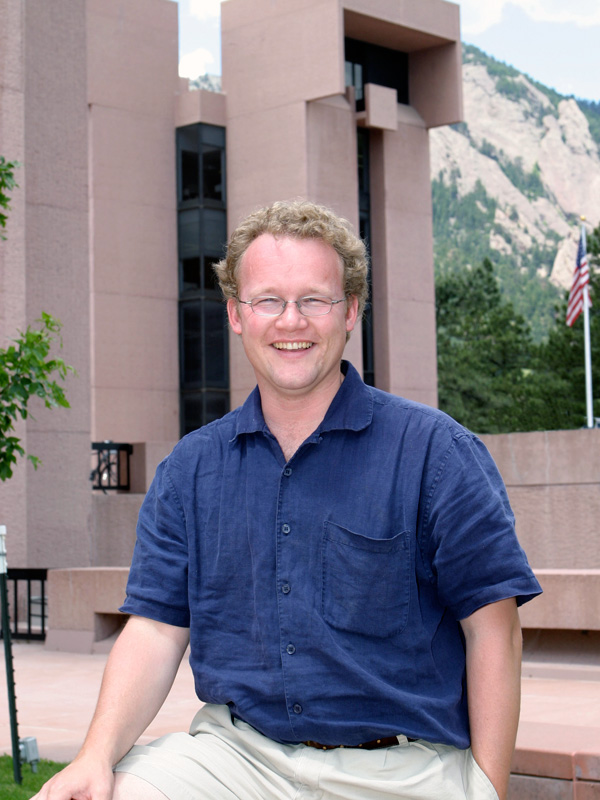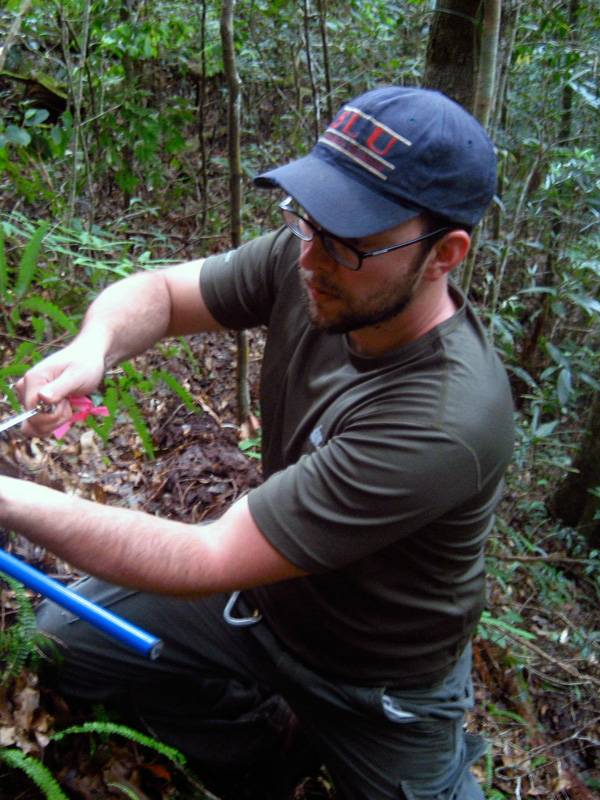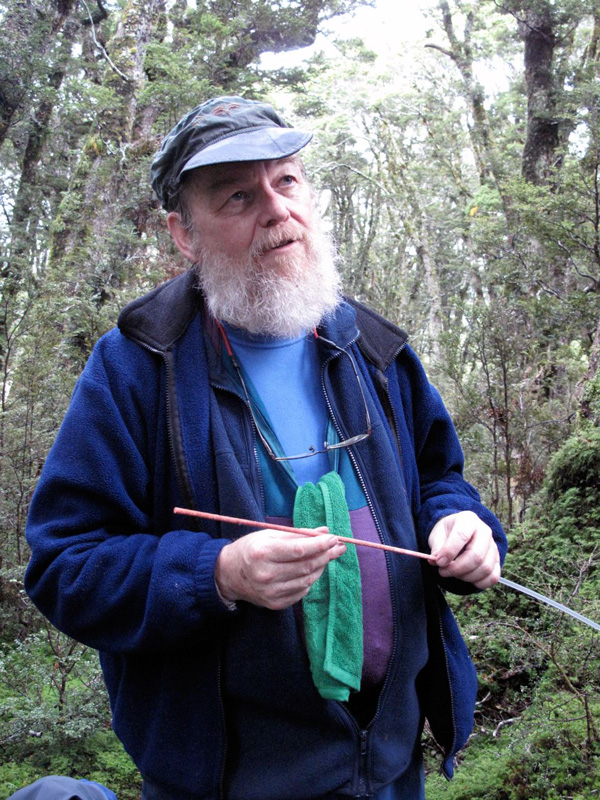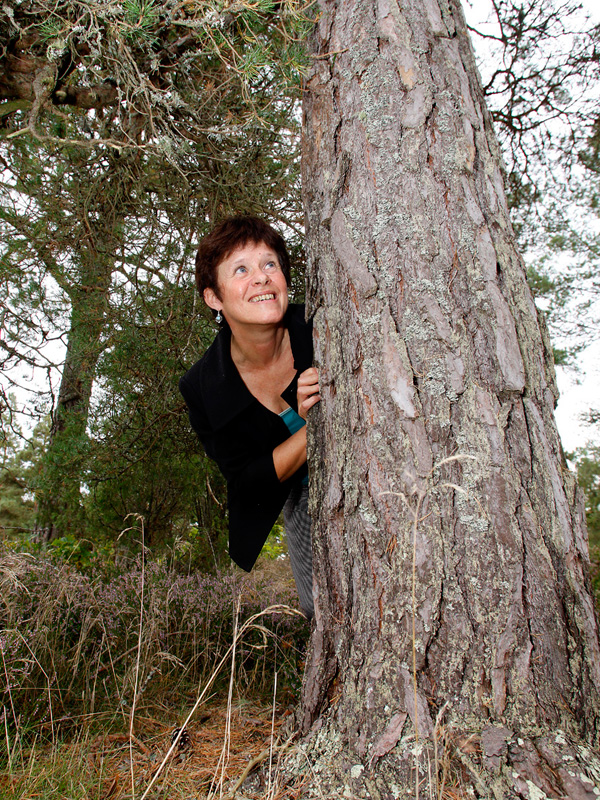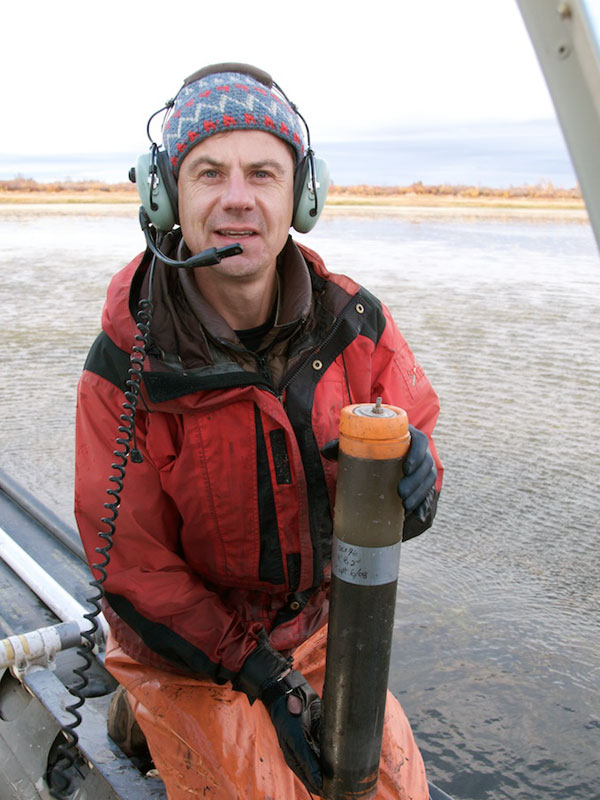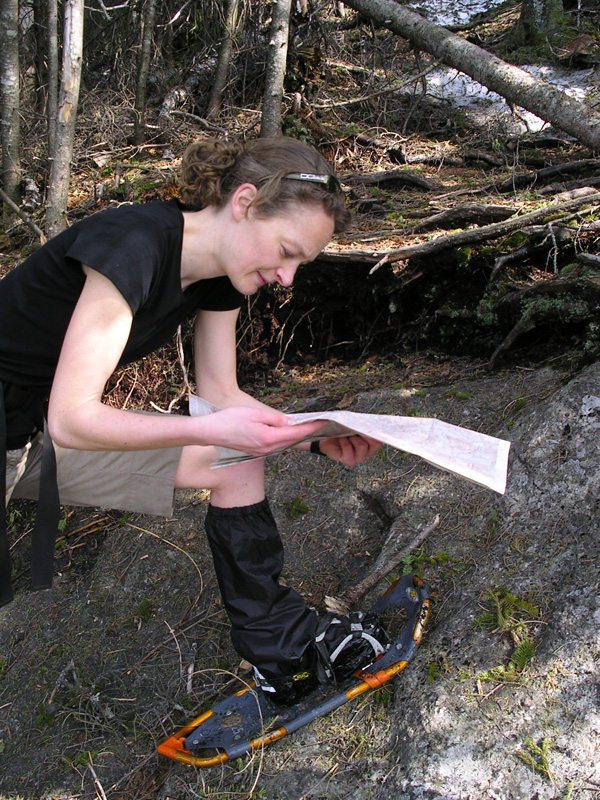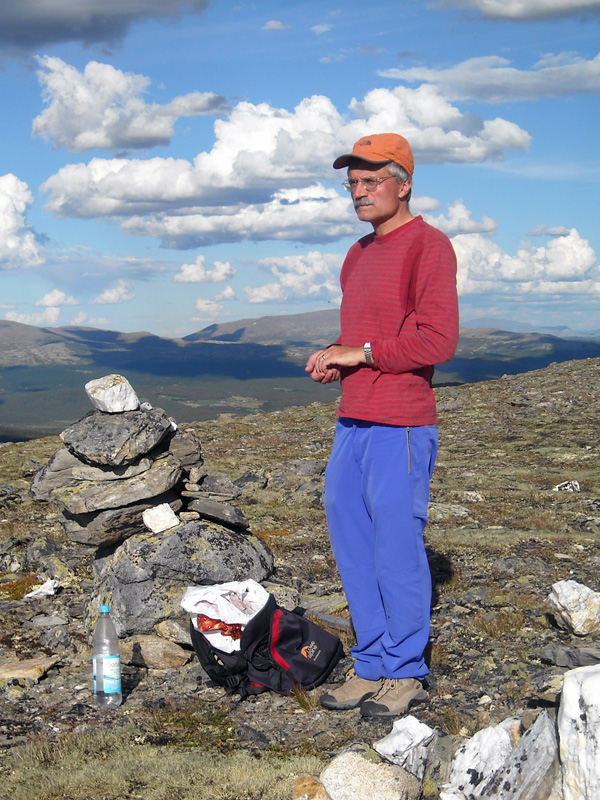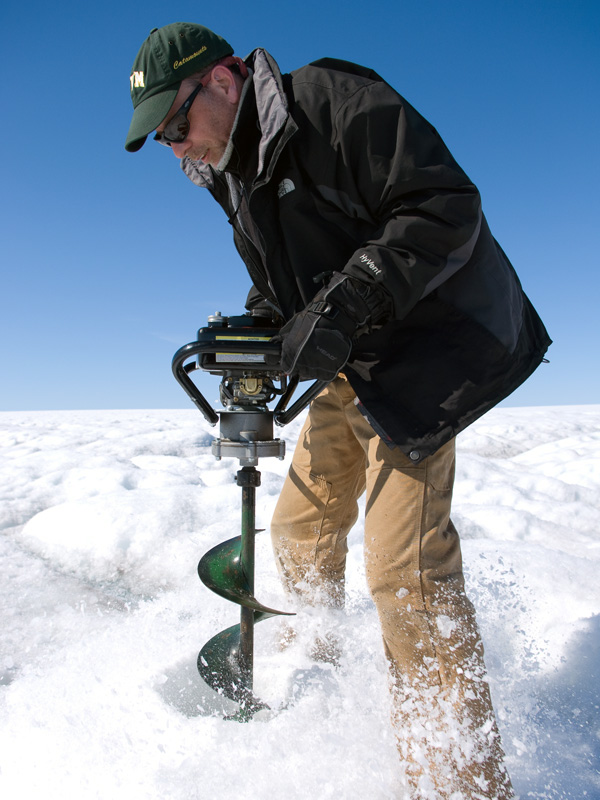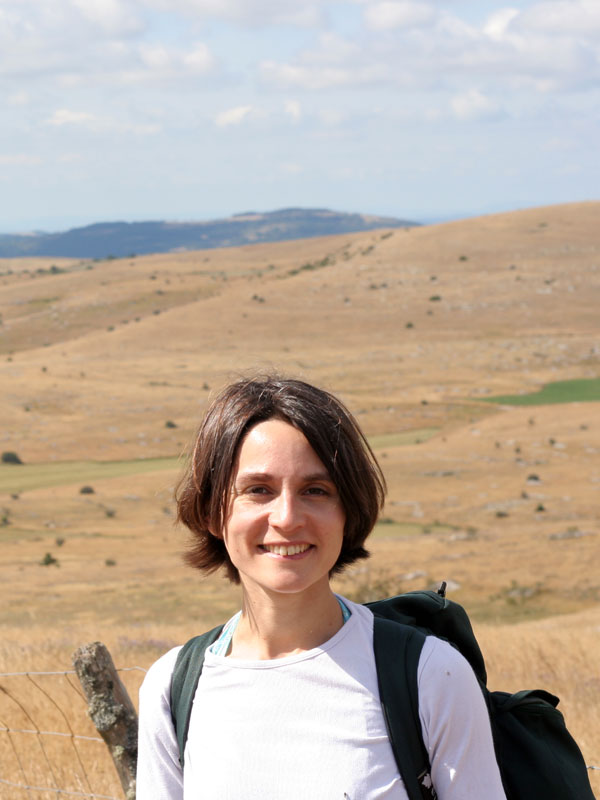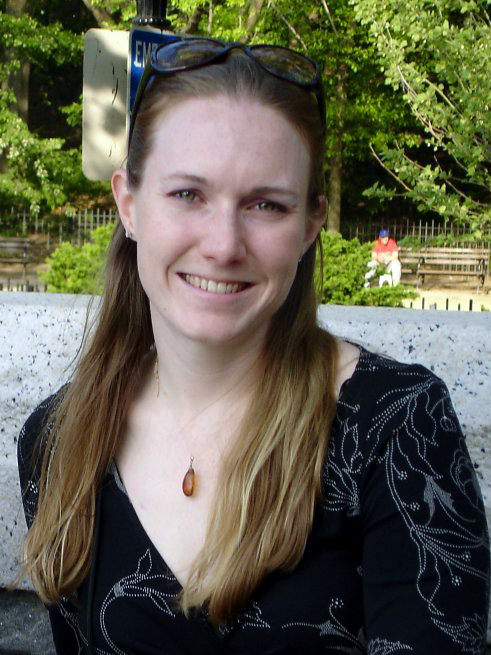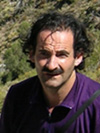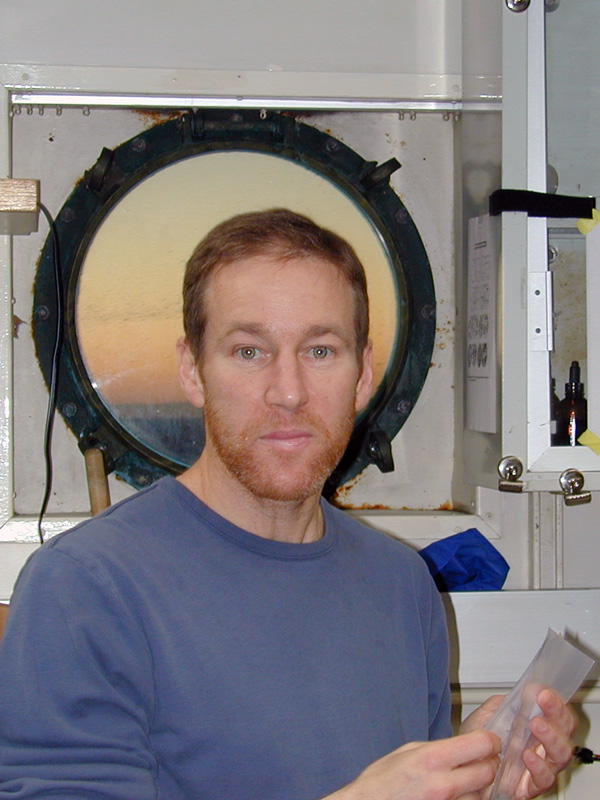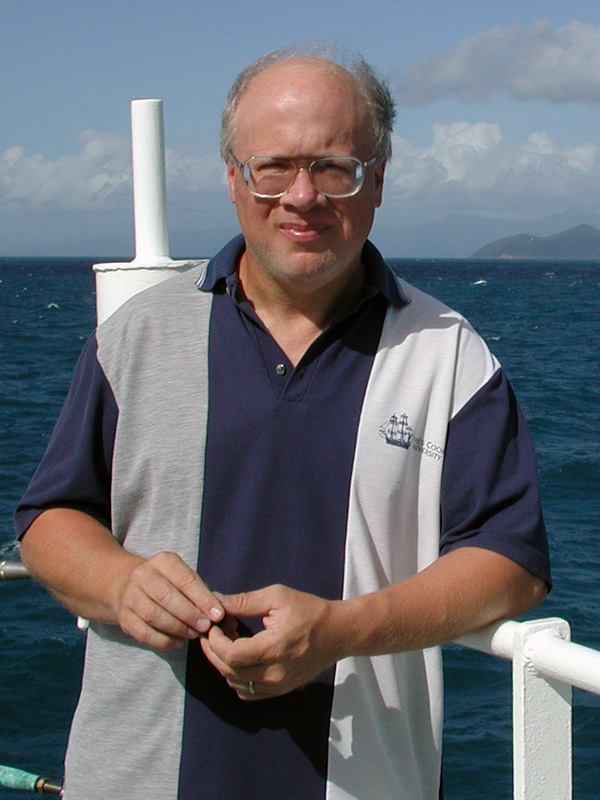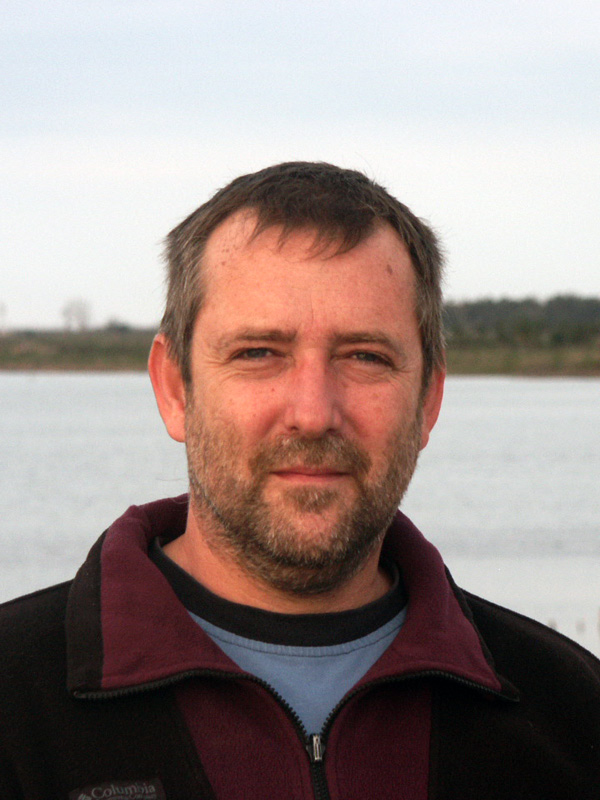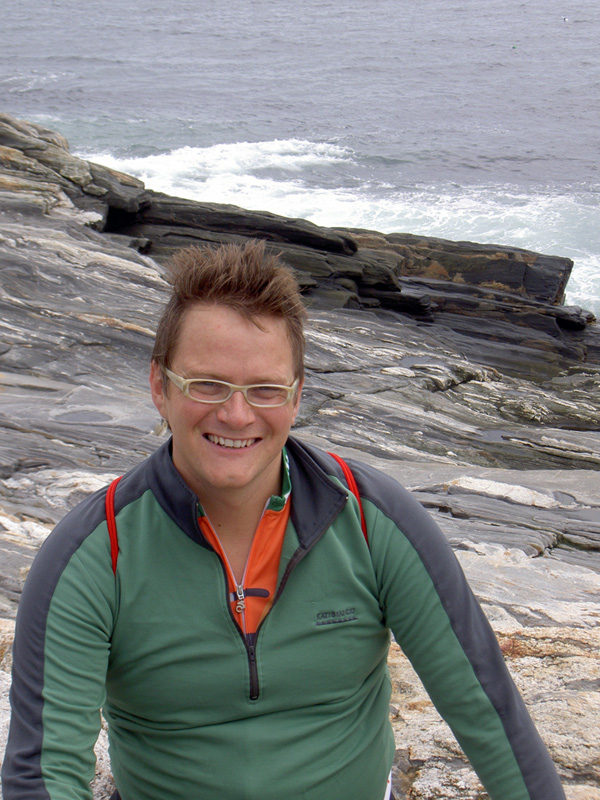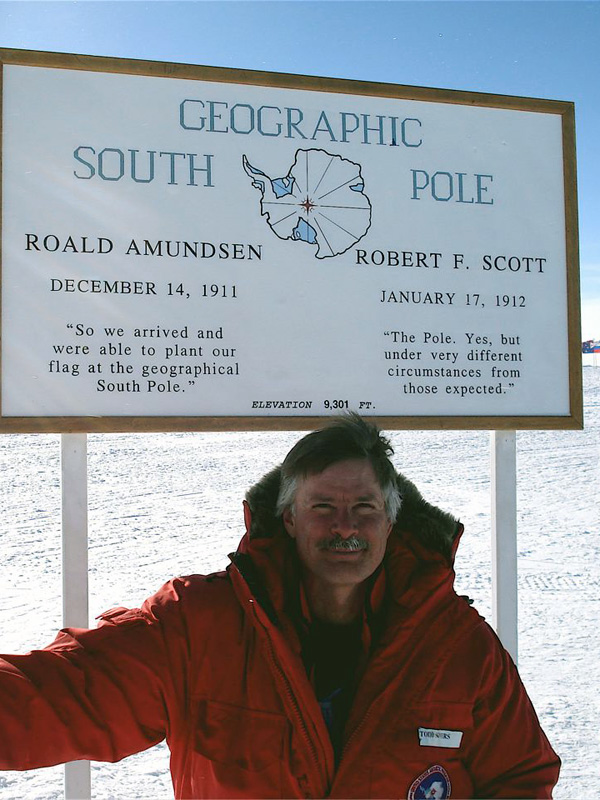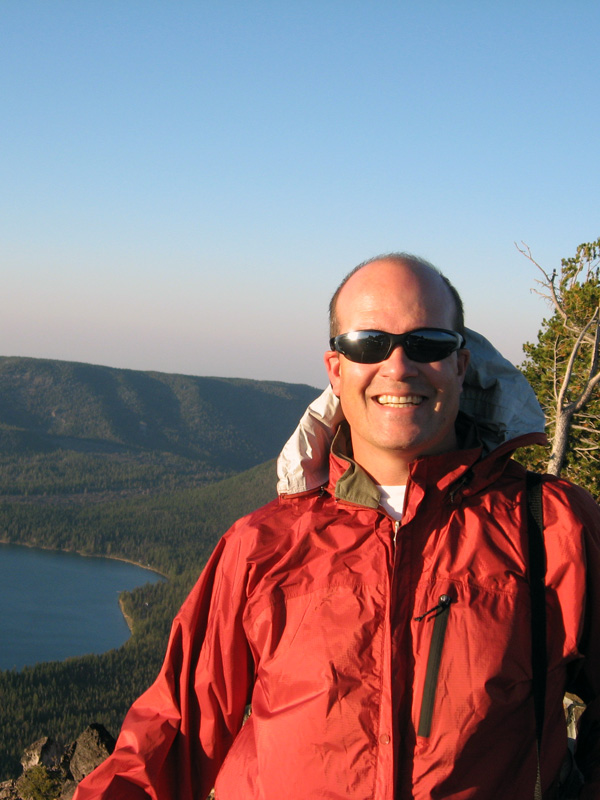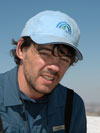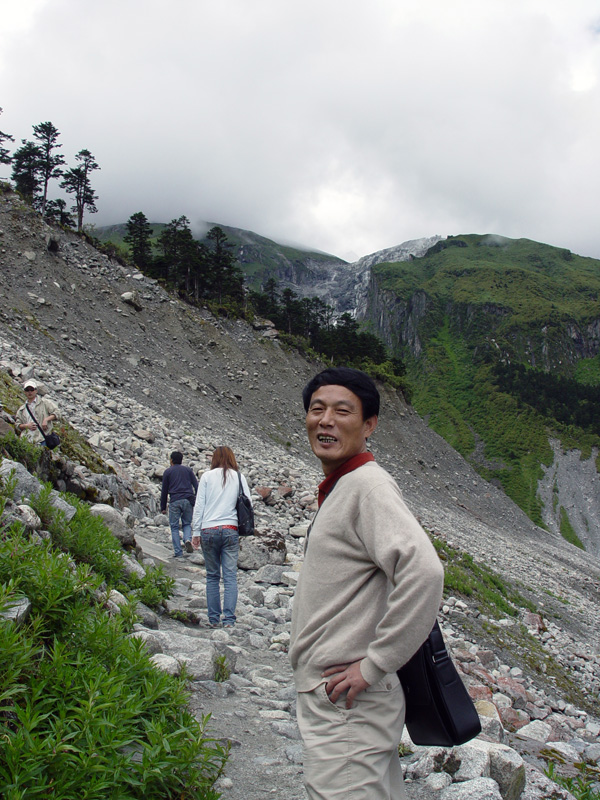|
|
Sea level change at glacial terminations and implications for future projections Ayako Abe-Ouchi Sea level change of as large as 1 meter per century during glacial terminations and the deglaciation of the Northern Hemisphere ice sheet (NHIS) are considered to provide useful information on the climate-ice sheet interaction and sea level rise associated with global warming. Many ice age models have been investigated either by simple or conceptual models or by forcing a 3D ice sheet model but the explanation for the 100 ka glacial cycles is still controversial and not clear. Here, the 3D ice sheet model (IcIES) with input examined by GCM (MIROC GCM) is forced by orbital parameters and atmospheric CO2 content obtained from ice cores (Vostok, EPICA and DomeF), whose dating is partly given by a new method using the N2/O2 ratio. In order to estimate the climate sensitivity to Milankovitch forcing and atmospheric CO2 indicated by ice core data, we used an atmospheric GCM (part of which is also used for future projection). Within the range of possibilities of the model, ice age cycles with a saw-tooth shaped 100 ka cyclicity, the volume of the major NH ice sheets and the geographical distribution at the glacial maximum were successfully simulated. With this model, we will discuss the role of CO2 and orbit for the 100 ka cycle and the response of ice sheets and sea level (namely “sea level sensitivity”) as well as the implication on the future sea level change. A. Abe-Ouchi — Center for Climate System Research, University of Tokyo, Japan |
|
|
The PAGES/CLIVAR Paleoclimate Reconstruction (PR) Challenge Caspar M. Ammann (pictured), Nicholas E. Graham, Rosanne R. D'Arrigo, Thorsten Kiefer Detailed understanding of the full range of annual and seasonal climate variability over the past millennium forms an important basis for the interpretation of the observed record and for gauging the response of the climate system to various forcings. Using different methods and proxy networks, the available climate reconstructions show general similarity in their depiction of large-scale mean temperature evolution, particularly at the decadal to century time scale. There are however important differences in reconstructions at the interannual and also at the multi-century to millennial scale. It is unclear how much these differences result from either the selection of specific proxy networks, the potential inability of included proxies to resolve information at all time scales, or the algorithms themselves (NRC 2007). The paleoclimate community needs to establish a protocol for reassessing its methods to rebuild confidence in the reconstruction efforts. The last millennium Paleoclimate Reconstruction (PR) Challenge, a community program run under the auspices of the PAGES-CLIVAR-Intersection, allows us to directly address these concerns and to establish objective reconstruction benchmarks. The basic idea is to use results from state-of-the-art coupled Atmosphere-Ocean-General Circulation Models (AOGCMs) in both open and blind-test reconstruction exercises. Individual reconstruction groups (and anyone who wants to participate) will be brought together and handed a small set of realistic pseudo-proxy series and calibration “instrumental data” drawn from the model output. They will be asked, to the best of their techniques’ ability, to reconstruct the simulated climate evolution. By comparing reconstructions with the full, “true” model climates, each group can assess their performance in great detail. A key objective of this project will be to document how much of the true climate can be described with the combined set of reconstruction results, to determine which aspects of the overall or regional climate are captured well, and whether important elements are being missed. Beyond the main goal of improved understanding of the performance of climate reconstruction methods, the PR Challenge will improve the exchange among the paleoclimate reconstruction groups and provides a flexible platform for enhanced interaction with the associated disciplines in Climate Modeling and Statistics. The latter might be particularly helpful with regard to a more formal assessment and quantification of uncertainty and regional climate understanding. The results of the PR Challenge will support and steer the community to develop strategies for improving the reconstruction methods so that past climate variations can be better understood. C.M. Ammann — Climate & Global Dynamics Division, NCAR, USA |
|
|
Tree-ring reconstructions of Australasian monsoon climate variability Kevin Anchukaitis (pictured), Rosanne D'Arrigo, Brendan Buckley The Asian Monsoon is one of the dominant features of the global climate system, influencing the lives of over half of the world’s population. A comprehensive understanding of the causes of variability in this system is critical to forecasting interannual and decadal anomalies in monsoon rainfall, as well as predicting changes in response to greenhouse gas forcing over the next several centuries. Because the monsoon is influenced by a complex series of interactions, including sea and land surface temperature patterns, and may be both directly or indirectly influenced by broad-scale changes in radiative forcing, the observed relationship between these various factors need to be placed in the context of the potential range of responses and low-frequency variability in the system. Without paleoclimate records, it is difficult to determine with confidence whether the manifestations and dynamic response to forcing of the Asian monsoon observed over the last century are stationary and fully representative of the range of possible variability. Here, we describe a series of results from our regional, multiproxy approach to developing robust spatiotemporal estimates of past Australasian monsoon precipitation and drought, and the associated sea surface temperature fields. We use tree ring and coral proxies from Indonesia to generate extended records of drought and ENSO for several centuries prior to the instrumental period. We also use a set of tropical coral and tree ring records to reconstruct the leading mode of Indian Ocean SST variability over the last four centuries. We present drought reconstructions over Australia, Indonesia, and Papua New Guinea that provide large-scale information on austral summer Australasian monsoon variability since 1787. Our proxies for this region include a new tree ring chronology from the tropical species Callitris intratropica in N Australia, as well as tree ring and coral-based data from Indonesia and NE Australia. Reconstructed drought and SST indices and fields are integrated into objective comparisons with general circulation model simulations in order to test various hypotheses concerning the dynamical causes of past epochs of significant monsoon anomalies. K. Anchukaitis — Lamont Doherty Earth Observatory, Columbia University, USA |
|
|
Luc Beaufort (pictured), Pascale Braconnot, Vincent Moron, Franck Bassinot, David Williamson Several studies have shown that climatic parameters in the tropics present an early phase with global climates in the precession band. This original phasing of tropical climates is analyzed here in details using a high-resolution record of ocean Primary Production (PP) in the Banda Sea. Satellite sensors indicate that PP in the Banda Sea increased during the Australian Winter Monsoon. During the last 160 ka, PP estimates exhibit profound and recurrent changes with a dominant 23 ka period in phase with other PP records from the tropical oceans. The PP records share great similarities with the Chinese speleothem δ18O record in terms of dynamics and phase. Of particular interest is the Holocene, when local minima in the two records between 10 and 8 ka are followed by a strong increase around 5 ka. This indicates that during the mid-Holocene, Australian Winter Monsoon winds increased when the Asian Summer Monsoon rains decreased. Numerical simulation of wind stress and rain fall at 9 ka and 6 ka with the IPSL-CM4 coupled model confirm this opposite response of the Monsoons in those two regions. Several other tropical records (African lake levels or paleo-ENSO) indicate similar and significant changes during the mid-Holocene in the absence of any observed higher latitude climate changes (e.g., temperatures in ice cores). We observe the same pattern during the penultimate interglacial (MIS 5e) when changes of Australian Winter Monsoon wind intensity precede by several thousand years the planktonic foraminifera δ18O record. We conclude that the dynamics of tropical climates are unique in that they directly follow precession and that they precede the onset of glaciations by thousands of years. L. Beaufort — CEREGE, CNRS & Aix-Marseille University, France |
|
|
Questions of importance to the conservation of global biological diversity: Answers from the past Kathy J. Willis, Shonil A (pictured). Bhagwat, Angelica Feurdean, Cynthia A. Froyd Paleoecological records are replete with examples of biotic responses to past intervals of climate change and human impact but how can we utilize these records in the conservation of current and future biodiversity? A recently published list of One Hundred Questions of Importance to the Conservation of Global Biological Diversity highlighted a number of key research questions that need a temporal perspective. These include questions related to ecosystem function and services, climate change conservation strategies, and ecosystem management and restoration. But is noticeable that not a single contributor to this list was from the paleoresearch community and that extremely few paleo-records are ever utilized in the development of terrestrial conservation management plans. This lack of dialog between conservationists and the paleocommunity is partially driven by a perception that that current and future rates and magnitude of change are more rapid than anything we have seen in the past, and therefore fossil records are of little use in the practical aspect of conservation. This talk will present a series of case studies to question whether this perception is correct. It will be argued that the fossil record can often provide effective analogs for predicted magnitude and rates of change that can be used as a first-order estimation of, e.g., community change, thresholds and migration rates in response to climate change. Additionally, although there may be no past analogs comparable to the current rate of anthropogenically driven land-use change, key datasets that fossil records can provide include rates and types of recovery following clearance, natural ecosystem baselines and disturbance regimes. Without such records, restoration and management of ecosystems can be misguided and in some instances, detrimental to their long-term survival. Using these examples, it will therefore be argued that paleo-datasets could and should be routinely incorporated into conservation management plans. The biggest question, however, is how to convey paleo-data in a format that is easily accessible and can be utilized by conservationists. K.J. Willis — Long-term Ecology Laboratory, School of Geography and the Environment, Oxford University, UK |
|
|
Climatic reconstructions from the Eastern Tropical North Pacific off Mexico: Geochemical proxies in corals and from deep ocean basins José D. Carriquiry The tropical-sub tropical transition zone of the Eastern Tropical North Pacific (ETNP) is one of the least-explored regions of the major ocean regions of the world, despite the tropical Mexican Pacific being recognized as a key region that modulates the climate of an important part of Mexico and North America. The recent climatic variability in the ETNP, was reconstructed from geochemical proxies of Sr/Ca and δ18O in corals from the mouth of the Gulf of California and San Benedicto Island (Revillagigedo Archipelago), covering a period from 52 to 174 years, with seasonal resolution. The skeletal Sr/Ca reflects the past sea surface temperature variability at interannual and multidecadal timescales. The interannual (3-7 years) Sr/Ca variability is highly coherent and in phase with the Niño3.4 SST anomaly. Strong interdecadal scale variability in the Sr/Ca record is clearly related to the Pacific Decadal Oscillation (PDO). Moving correlation coefficients (21-year window) between the tree ring and instrumental PDO indexes, and the interdecadal San Benedicto Sr/Ca record show a positive correlation in the 20th century. The oxygen isotopic (δ18O) composition of corals is controlled both by SST and by δ18O of seawater (δ18Ow). The δ18Ow variation reconstructed from δ18O and Sr/Ca responds directly to the changes in the regional sea surface salinity (SSS) and with the hydrologic balance (E - P). The δ18Ow shows a freshening trend during the last four decades, coherent with the trend analyses of salinity or precipitation. The δ18Ow from the San Benedicto coral varies with the long-term changes in the average position of the Intertropical Convergence Zone (ITCZ) in the northeastern Pacific. The correlation between δ18Ow and the changes in the ITZC position, as well as the long-term changes in δ18Ow show low frequency variability, in phase with the interdecadal changes in the intensity of the ENSO events. A more negative δ18Ow, that implicate periods of rainfall higher than average, are coincident with periods of strong ENSO activity. A complementary study using sediment cores retrieved from the Magdalena Margin off Southern Baja California reveal that at millennial timescales, primary productivity responds in concert with Dansgaard-Oschger cycles. J.D. Carriquiry — Instituto de Investigaciones Oceanológicas, Universidad Autónoma de Baja California, Mexico |
|
|
Reconstructing climate over the past millennium: The need for replication, calibration, and verification from a tree ring perspective Edward Cook (pictured), Neil Pederson The importance of paleoclimate research for understanding both past and present climatic change over the last 1000 years is now well recognized. This climate interval is of particular interest because it contains two contrasting periods of climate: Medieval Warm Period (MWP) and Little Ice Age (LIA). Comparing 20th century warming to the MWP and LIA has centered on the detection of climatic change and its attribution as the Fourth Assessment Report of the Intergovernmental Panel on Climate Change amply shows. Here, annually resolved and well-dated paleoclimate proxies have led the way, with exactly dated annual tree ring chronologies playing perhaps the most prominent role. However, there are other paleoclimate proxies with similar attributes to tree rings that have been used in climatic change studies over the past millennium, e.g., ice cores, corals, laminated sediments, and speleothems. Traditionally, climate reconstructions from tree rings have been developed from well-replicated tree ring chronologies using statistically fitted calibration models that transform the tree rings into estimates of climate back in time. These tree ring estimates are typically tested for accuracy against withheld climate data not used for calibration using a number of model validation or verification tests. The principles of replication (and the precise dating control that it makes possible), calibration, and verification should similarly be used, when possible or resources permit, in the development of climate reconstructions from other paleoclimate proxies like ice cores and corals. The importance of these principles to high-resolution paleoclimate research is illustrated with tree ring examples and an emerging set of examples from other paleoclimate proxies. E. Cook —Tree-Ring Laboratory, Lamont-Doherty Earth Observatory, USA |
|
|
Interactions between Holocene land-cover and climate change in Europe Marie-José Gaillard (pictured), Shinya Sugita, Anna-Kari Trondman, Florence Mazier, Anna Broström Paleoenvironmental reconstructions are critical for developing and evaluating predictive models of climatic and environmental change. There is a growing need for new syntheses of paleorecords at global-continental scales to test theories on climate-ecosystem-human interactions and to improve mechanistic understanding. The NordForsk LANDCLIM network (2009-2011) is a platform for dialog between paleoecologists and climate modelers (including dynamic vegetation models). Its major focus is on regional vegetation and land cover reconstructions (ca. 104-105 km2) over Europe for selected time windows of the Holocene, and evaluation of feedbacks of human-induced land-cover changes on past regional climate. The network is a contribution to the “land-cover theme” of PAGES-PHAROS. Similar initiatives are under development for other continents (N and S America; Africa, China, India). The non-linear nature of the pollen-vegetation relationship has made it difficult to quantify past land-cover changes using fossil pollen. The REVEALS model uses pollen records from large sites to quantify vegetation and land cover at the regional spatial scale. REVEALS was empirically tested and validated in southern Sweden and central Europe. The number of plant taxa for which estimates of pollen productivity required for REVEALS applications are available has rapidly increased in many parts of Europe and other parts of the world. The first REVEALS-based reconstructions of Holocene vegetation in Europe indicate that changes in landscape openness during Early and Late Holocene were more substantial than changes in pollen percentages alone would suggest. Therefore, vegetation openness caused by both natural and anthropogenic disturbances may have played a more important role in the land surface-atmosphere interactions than previously assumed. The importance of fire during Early and Late Holocene in terms of interactions between Holocene land-cover and climate will also be discussed. M.-J. Gaillard — School of Pure and Applied Natural Sciences, University of Kalmar, Sweden |
|
|
Eric Galbraith It has been hypothesized that physical climate changes caused the ocean's biological pump in the cold, glacial world to be more effective at sequestering carbon dioxide. However, even in the absence of changes in ecosystem function (e.g., due to iron fertilization), determining the mechanisms by which physical climate variability alters the biological pump is not simple. For example, how are long-term changes in the mean state related to transient climate events? Are the circulation impacts of global warming and cooling straightforward across timescales? Global, coupled ocean-atmosphere circulation models, with prognostic biogeochemistry modules, offer useful tools for exploring these problems. Here, I show model responses of the biological pump to idealized modifications of global climate. The purpose is not to reproduce past climate variability, but rather to expose dominant mechanistic responses to strong transient climate forcings. The analysis focuses on the response of nutrient cycling of polar oceans to these simple climate forcings, and the attendant global impacts. E. Galbraith — Department of Earth and Planetary Sciences, McGill University, Canada |
|
|
The importance of paleolimnological data for management of water quality and quantity Roland Hall As human pressures and climate change continue to intensify on our aquatic resources, there is increasing need to develop and refine scientific methods that can determine pre-impact conditions and natural variability, quantify the timing, magnitude and rates of change, and evaluate the relative roles of multiple interacting stressors. Many processes that affect the quantity and quality of surface waters operate over broad temporal (seasons to decades or longer) and spatial scales. The spatial and temporal scope of available long-term monitoring records is usually insufficient to accurately identify the causes of change, though such knowledge is required for development of effective management strategies and pro-active policy. I will provide several examples from around the world where paleolimnological data have provided critical insights about the factors that regulate the quality and quantity of water in systems, and to address conflicts and conservation challenges. One example is from the Peace-Athabasca Delta (PAD), a floodplain landscape that is one of Canada’s 15 UNESCO World Heritage Sites. Despite national efforts to preserve this important northern freshwater ecosystem, conflict and controversy have grown over the past four decades because of the perception that the WAC Bennett hydroelectric dam has reduced ecologically important flooding. Monitoring data and scientific studies of insufficient duration reinforced the notion that the dam lowered water levels and reduced flooding in the PAD. However, paleolimnological data spanning the past 100-1000 years revealed that climatic changes, and not the dam, are the dominant driver that have altered the amount and timing of river discharge. Broad temporal and spatial perspectives provided by the paleolimnological study were essential to identify how the PAD landscape has evolved and responded to climate change—two critical knowledge gaps that have long hampered effective ecosystem stewardship. R. Hall — Department of Biology, University of Waterloo, Canada |
|
|
Boron isotope perspective on the CO2 history beyond ice cores Bärbel Hönisch (pictured), Gretta Bartoli, Richard E. Zeebe, N. Gary Hemming, David Archer, Mark Siddall, Jerry F. McManus When was the last time that atmospheric CO2 was as high as today and what was the climate like at that time? This is difficult to answer because direct measurement of atmospheric CO2 from ice cores are restricted to only the past 800 kyr, and it is clear that one must go back much further to find CO2 concentrations as high as today. Because CO2 is well mixed in the atmosphere, and because CO2 is exchanged between the surface ocean and atmosphere, marine proxy records of past sea surface carbonate chemistry can place constraints on past atmospheric pCO2. We present records of sea surface PCO2 based on boron isotopes in planktic foraminifer shells, which suggest a close linkage between atmospheric pCO2 and global climate beyond existing evidence from ice cores. Over the past 2.1 Ma, PCO2 levels were relatively stable but glacial PCO2 prior to 1 Ma was ca. 30 µatm higher than during late Pleistocene glacials. These data correlate well with benthic oxygen isotope records, which suggest interglacial land ice extent and/or deep-sea temperatures were relatively constant over the past 2.1 Ma but glacial periods prior to 1 Ma were relatively less extreme. The climate analog for modern pCO2 levels must date back even further than this, possibly to the time before the acceleration of Northern Hemisphere glaciation, when benthic oxygen isotope values were much lower. A boron isotope study for the Pliocene is in progress and preliminary data suggest similar PCO2 levels to the modern at that time. B. Hönisch — Department of Earth and Environmental Sciences, Lamont-Doherty Earth Observatory of Columbia University, USA |
|
|
Climate and biogeochemical cycles of greenhouse gases: Lessons from the past Fortunat Joos Reconstructions of past greenhouse gas and climate variations provide invaluable information on the intricate coupling between the physical climate system and biogeochemical cycles, and how this coupling will affect the ongoing human-made global warming. This talk will provide a few illustrative examples. Rates of anthropogenic forcing are compared with rates of natural greenhouse gas forcing since the Last Glacial Maximum and of solar and volcanic forcing of the last millennium. The smoothing of atmospheric variations by the enclosure process of air into ice is computed with a firn diffusion and enclosure model. The 20th-century increase in CO2 and its radiative forcing occurred more than an order of magnitude faster than any sustained change during the past 22,000 years. Carbon cycle-climate feedbacks potentially accelerate ongoing man-made warming. However, the magnitude of this feedback remains uncertain. Reconstructed changes of CO2 and Northern Hemisphere temperature during the last millennium are used to constrain the magnitude of the feedback. The processes responsible for the 20 ppm variations in CO2 over the pre-industrial Holocene are discussed in the light of new isotopic data and results from Earth System models. The primary drivers of Holocene CO2 variations are terrestrial uptake related to ice retreat and peat accumulation, and changes in the marine carbonate system related to sediment compensation of earlier terrestrial uptake and changes in coral reef growth. Simulations forced by changes in anthropogenic land-use yield only small changes in CO2, fully compatible with the isotopic evidence from ice cores. The equatorward displacement of the Southern Hemisphere westerly winds has been proposed as a mechanism to explain low glacial atmospheric CO2. In contrast to the hypothesis, the Bern3D ocean model yields an increase in atmospheric CO2 for a northward shift in the Southern Hemisphere westerlies. F. Joos —Physics Institute and Oeschger Centre for Climate Change Research, University of Bern, Switzerland |
|
|
Observations of ice sheet change Ian Joughin (pictured), Ben Smith, Ian Howat The conventional wisdom of earlier decades was often that ice sheets varied little on decadal and shorter timescales. As the ability to use satellite observations to measure ice flow has advanced, several recent observations of speedup (50-100%) on glaciers and ice streams in Greenland and Antarctica have altered this perception. Many of these events were observed just as the Intergovernmental Panel on Climate Change (IPCC) was finishing its Fourth Assessment in 2007. These recent changes are large, rapid, and well beyond what can be predicted by the whole ice sheet models used to make sea level assessments. This has revealed large gaps in our understanding of how outlet glaciers and ice streams respond to climate change, and led the IPCC to conclude that poorly understood ice-dynamics related processes may cause significant contributions to sea level, for which we can derive no upper bound based upon our present knowledge. As the observational record increases in length, we find that the changes are complicated with periods of both speedup and slowdown, not following any simple trend. We will describe results from several areas on the ice sheets to illustrate the complexity of this flow, the physics of which must be included in the models used to assess future sea level. I. Joughin — Polar Science Center, University of Washington, USA |
|
|
Climate changes in the European Arctic during the last 2k Atte Korhola (pictured), Minna Väliranta, Heikki Seppä, Lasse Holmström, Panu Erästö, Nalan Koc Documenting past climate variability is vital for understanding present climate and predicting future change. Late Holocene climate variations are particularly important because natural forcings and the Earth’s boundary conditions were approx. similar to those operating today. The increased focus on the late Holocene is motivated also by the recognition that substantial and possibly global climate oscillations have occurred during the past few millennia in response to a pacemaker that also forced the larger magnitude glacial events. During the late Holocene, climate development in the European Arctic was punctuated by centennial-scale warmer and colder episodes. However, there has been much discussion about the magnitude and geographical extent of these events, as well as moisture conditions during these periods. Our studies on peatland proxies demonstrate that effective moisture increased during the Dark Age Cold Period (DACP) ca. 300-800 AD, Little Ice Age (LIA) between 1550-1800 AD and during the Current Warm Period (CWP), from 1920 onwards, whereas drier conditions prevailed during the Roman Warm Period (RWP) prior to 300 AD, Medieval Warm Period (MWP) 800-1200 AD, between 1400-1550 AD, and during the latter part of the LIA, i.e., ca. 1800-1920 AD. This latter dry phase in the 19th century is particularly interesting, as it clearly demonstrates that LIA was not wet throughout in northern Europe. Inferred wetter conditions during the 20th century agree with the observed intensification of the global water cycle and the predicted increase of precipitation in northern Europe. We postulate that variability in 20th century precipitation and temperature in the European Arctic is probably caused by anthropogenic greenhouse gases and aerosols. Future research should focus on the long-term influence of mid-latitude atmospheric circulation on Arctic climate. PAGES Working Group on arctic climate during the last two millennia is a new initiative to generate and synthesize high-resolution paleoclimate data to assess and elucidate both the timing and variability of the Arctic climate change during this period. A. Korhola — Department of Biological and Environmental Sciences, University of Helsinki, Finland |
|
|
Scaling future sea-level change: Lessons from the termination Amaelle Landais (pictured), Emilie Capron, Bénédicte Lemieux-Dudon, Adrian Schilt, Valérie Masson-Delmotte, Jean Jouzel, Daphné Buiron, Jérôme Chappellaz, Laetitia Loulergue, Markus Leuenberger, Hans Oerter, Barbara Stenni, Dorthe Dahl-Jensen, Sigfus Johnsen The Marine Isotope Stage (MIS) 5, characterized by relatively high sea level, is recorded with great detail in a few Antarctic and Greenland ice cores. We will present recent results obtained within the EPICA and NorthGRIP ice coring efforts depicting with high resolution the rapid variations of local temperature, greenhouse gases concentration and isotopic composition of atmospheric oxygen (which we will show is largely driven by changes in productivity over land) over this time period. This permits us to show the particularity of interstadials associated with Dansgaard-Oeschger-mode climate over MIS 5 with respect to the “classical” interstadials of MIS 3. It is shown that interstadials are especially large during MIS 5 and that a sub-millennial timescale climatic variability can be identified at the beginning and during the course of an interstadial. We also use global tracers as a tool to synchronize Greenland (NorthGRIP) and Antarctic (EPICA Dronning Maud Land) records, in order to depict the North-South sequences over the millennial- and sub-millennial-scale climatic variability of MIS 5. This reveals that the see-saw behavior identified during the glacial MIS 3 is also at play over the warm MIS 5, even at sub-millennial timescales. Finally, we focus on the first interstadial of MIS 5 (IS 25) and question the specificity of such an event. A. Landais — Laboratoire des Sciences du Climat et de l’Environnement, CEA-CNRS-IPSL, France |
|
|
On understanding which climate signals are captured in water isotope records Allegra LeGrande (pictured), Gavin Schmidt, Sophie Lewis, Maxwell Kelley Water isotope records collectively provide some of the most extensive proxy evidence for past climate; quantitative climate reconstruction requires that the relationship between the two on many timescales is well determined. Modern analog methods illustrate that mid- to high-latitude atmospheric water isotope variability correlates to temperature changes, while low-latitude variability correlates to precipitation changes. Similarly, regional oceanic water isotope variability correlates to salinity variability. Thus, water isotope variability is used to infer past climate variability. However, climate variability (seasonal through millennial) implies variability in the hydrologic cycle, potentially impacting water isotope distribution in distinctive ways from other climate parameters. Thus, the water isotope-to-climate correlation may be variable through time. We assess the relationship between water isotopes and climate, and infer the primary controlling mechanisms on a variety of timescales using GISS ModelE-R, a fully coupled atmosphere-ocean General Circulation Model equipped with water isotopes and an additional 144 “vapor source distribution” tracers. We present several case studies where the climate signal in water isotopes is more complex than that implied by the “modern analog” technique: (1) Water isotope records from Asian speleothems are often interpreted as measures of paleo-“monsoon” strength, with “monsoon” defined as local precipitation. However, local precipitation changes over land are not well correlated to local isotope changes. We find Asian water isotope variability most closely related to the tropical hydrologic cycle strength. (2) Vapor-source distribution changes for Summit, Greenland are an important factor in controlling water isotope variability, complicating the temperature correlation there. (3) Alterations in inter-basin exchange of moisture on long timescales forces a divergence of seawater salinity and water isotope co-variability, limiting the ability of ‘modern analog’ techniques to infer paleosalinity variability from isotopes. Water isotopes capture climate changes in the past, though the signal they capture is more complex than implied by the simplified interpretations of “modern analog” techniques. A.N. LeGrande — NASA Goddard Institute for Space Studies, and Center for Climate Systems Research, Columbia University, USA |
|
|
Tree ring records of South America for paleoclimate reconstructions of the last millennium Carlos LeQuesne (pictured), Juan Carlos Aravena, Jonathan Barichivich, José Armando Boninsegna, Duncan A. Christie, Antonio Lara, Brian H. Luckman, Mariano H. Masiokas, Mariano S. Morales, Fidel A. Roig, David Stahle, Rocío Urrutia, Ricardo Villalba Given its large north-south extension, South America is characterized by tropical, subtropical and extratropical climatic features. The prominent elevation of the Andes Cordillera, which is located near the western coast of the continent, strongly conditions the regional climate and restricts the occurrence of suitable tree species for paleoclimate reconstructions largely to this vicinity. Up to today, South American dendroclimatology has yielded reconstructions of rainfall, temperature, streamflow and regional atmospheric circulation indices, mainly from subtropical and extratropical latitudes (32-55°S), some of which extend back to the last millennium. During the last decade, significant advances have been made to extend the spatio-temporal coverage of the South American tree ring network. These records cover the Andes from the Altiplano (~17°S), where the world’s highest elevation tree ring chronologies (4000-5000 m asl) are located, all the way to the southern tip of Patagonia (~55°S). Rainfall reconstructions of the Central Andes of Chile and Argentina for the past 800 years show dry spells during the mid-1400s and 1600s, along with a significant decreasing return time of drought during the 20th century. A multi-millennial-long temperature reconstruction (3622 yr) suggests extended periods with above and below average temperature in northern Patagonia. Temperature reconstructions also indicate unprecedented warmer conditions during the 20th century in southern Patagonia. Streamflow reconstructions of northern Patagonia have exhibited a decreasing trend since the mid-20th century. In these paleoclimate registries, we can find fingerprints of both tropical (ENSO) and high-latitude (AAO) climatic forcings interacting along this broad section of the Andes. Since our knowledge of late- Holocene climate variability based on high-resolution climate proxies is particularly scarce in the Southern Hemisphere, the longevity of various tree species in conjunction with the presence of well-preserved remnant wood, encourage us to continue developing the current South American tree ring network. Our goal is to improve the spatial and temporal coverage of these records and develop new millennial gridded reconstructions of past climate. C. LeQuesne — Laboratory of Dendrochronology, Universidad Austral de Chile, Chile |
|
|
European climate dynamics over past centuries and multi-decadal circulation-climate relationships Jürg Luterbacher (pictured), Marcel Küttel, Heinz Wanner, Christian Pfister We present the latest multiproxy-based seasonal-climate field reconstructions for Europe covering the past half millennium fitted to new spatially highly resolved gridded data (provided by the Climatic Research Unit, University of East Anglia). We applied the regularized expectation maximization (RegEM) algorithm to long high-quality instrumental-station series (last 250 years), documentary proxy evidence and natural proxies (last 500 years). We also present the first documentary based evidence for winter and summer temperature changes in Western Europe from the Medieval Climate Anomaly (MCA) to the modern period. During the MCA, even in the “warm” 13th century, famine-ridden years “without a summer” triggered by large volcanic eruptions occurred repeatedly. At least 16 winters between 1100 and 1400 were extremely cold. J. Luterbacher — OCCR, University of Bern, Switzerland and Department of Geography, Justus-Liebig University of Giessen, Germany |
|
|
Lessons from the past for sustainable development: A case study using the paleorecord from East Africa Rob Marchant (pictured), Antje Ahrends, Jemma Finch, Colin McClean, Cassian Mumbi, Veronica Muriri, Phil Platts, Stephen Rucina East Africa is characterized by an extremely rich paleoecological archive that offers exceptional insights into how ecosystems have responded to past climate changes, and how humans have interacted with their environment over millennia. East Africa is also characterized by a diverse range of environments with strong economic, social and cultural ties to natural resources. Under projected future climate change, the relationship between the people and the environment will become strained with competing demands for natural resources such as water, land for crop production, pastoralism and tourism. For example, although the Eastern Arc Mountain biodiversity hotspots of Tanzania and Kenya are increasingly recognized as valuable for provision of ecosystem services and a national resource vital to the continued national development, there is continued forest clearance with environmental impacts. By combining biogeography, ecosystem modeling and paleoecological research output, ecosystem responses to environmental changes in East Africa have been determined through the past, present and future temporal chain. The paleoecological archive shows that ecosystems in certain locations are more responsive than others to climate change; this past perspective clearly demonstrates the importance of aspect and forest cover in generating local and regional hydrology. More recently, paleoecology has been able to chart the history of human forest interactions and place the current human-dominated biomes in context. The enhanced understanding of past ecosystem dynamics is used to constrain models of how ecosystems and the associated services (biodiversity, carbon, hydrology, non-timber forest products, timber and tourism) will change under predicted future climatic, governance and economic scenarios. These future projections, based on a foundation of past response of ecosystems to environmental and anthropogenic interaction, can increase the potential for successful sustainable development. R. Marchant — York Institute for Ecosystem Dynamics, University of York, UK |
|
|
Climate and human impacts on biomass burning during past millennia Jennifer Marlon, Global Palaeofire Working Group Unusually severe wildfire activity has become one of the most visible and destructive hallmarks of climate change but disentangling the influences of climate and humans on current fire regimes is difficult. Fire history can provide insights into the relationships between climate and fire in the past, and how these relationships have been modified by human activities. We use syntheses of paleofire data based on sedimentary charcoal records to document long-term changes in fire regimes and to understand when human influences on global fire regimes first became apparent. Analyses on regional- to global-scales indicate that relatively low levels of biomass burning occurred worldwide during the last glacial period, most likely due to the generally cold, dry conditions and low CO2 levels that limited fuel availability. Burning increased through deglaciation, with periods of abrupt warming marked by widespread increases in biomass burning and fire frequency. Biomass burning was relatively high though spatially variable during the Holocene. In general, broad-scale changes in biomass burning tracked changes in temperature, with levels of burning tending to increase whenever the climate warmed, and vice versa. Human activity is not evident in the global record of biomass burning until about 1750 AD, when it is associated with a large rise in burning until about 1900 AD. Only human activities can account for a rapid decline in biomass burning during the past century, which we attribute to widespread changes in land-use, including agriculture and grazing. J.R. Marlon — Dept. of Geography, University of Oregon, USA |
|
|
Regional warmth and variability of interglacial climates The global trend towards increasingly extreme and extended ice ages has been repeatedly interrupted by geologically brief warm interglacial intervals with a large diversity of intensity, duration and internal variability. In addition to climate archives on land, high-resolution deep sea sediment records from selected locations provide a window into past interglacial climate. Here, we discuss records of deep sea and sea-surface hydrography from the sub-polar North Atlantic Ocean during interglacial intervals of the last million years, derived from sediment drift sites on the flank of the Rockall Plateau (ODP Site 980) and Reykjanes Ridge (ODP Sites 983 and 984). Although the interglacial climates do not display the same magnitude of climate instability as glacial intervals, we do recognize a persistent millennial variability within several past warm intervals. Based on evidence from the last peak interglacial marine isotope substage 5e (MIS 5e), these rapid climate variations were associated with changes in ocean circulation, possibly mediated by freshwater perturbations. As MIS 5e appears to be the warmest interglacial interval regionally and possibly globally, it is useful to compare it to previous intervals to see if the magnitude of millennial climate variations may be related to the additional warming and associated melting of ice. The regional warmth during marine isotope stage 11 was similar to the Holocene, for a far longer interval. Planktic isotopic records reveal repeated sea surface temperature oscillations of ca. 2°C, which may also be related to changes in ocean circulation. J.F. McManus — Department of Earth and Environmental Science, Columbia University and Department of Geology and Geophysics, Woods Hole Oceanographic Institution, USA |
|
|
Dirt: The erosion of civilizations David R. Montgomery Data drawn from a global compilation of studies support the long articulated contention that erosion rates from conventionally plowed agricultural fields greatly exceed rates of soil production, erosion under native vegetation and long-term geological erosion. Whereas data compiled from around the world show that soil erosion under conventional agriculture exceeds both rates of soil production and geological erosion rates by up to several orders of magnitude, similar global distributions of soil production and erosion rates suggest an approximate balance. Net soil erosion rates in conventionally plowed fields on the order of 1 mm/yr can erode typical hillslope soil profiles over centuries to millennia, timescales comparable to the longevity of major civilizations. Well-documented episodes of soil loss associated with agricultural activities date back to the introduction of erosive agricultural methods in regions around the world, and stratigraphic records of accelerated anthropogenic soil erosion have been recovered from lake, fluvial, and colluvial stratigraphy, as well as truncation of soil stratigraphy (such as truncated A horizons). A broad convergence in the results from studies based on various approaches employed to study ancient soil loss and rates of downstream sedimentation implies that widespread soil loss has accompanied human agricultural intensification in examples drawn from around the world. While a broad range of factors, including climate variability and society-specific social and economic contexts—such as wars or colonial relationships—all naturally influence the longevity of human societies, the ongoing loss of topsoil inferred from studies of soil erosion rates in conventional agricultural systems has obvious long-term implications for agricultural sustainability. Like the issues of climate change and loss of biodiversity, the ongoing global degradation and loss of soil presents a fundamental social challenge in which the slow pace of environmental change counter-intuitively makes solutions all the more difficult to adopt. D.R. Montgomery — Department of Earth and Space Sciences, University of Washington, USA |
|
|
Synthesis of Antarctic climate over the past 40,000 years from ice cores Robert Mulvaney on behalf of the International Partnerships in Ice Core Sciences (IPICS) community The deep ice cores from central Antarctica have arguably become the gold standard for detailing changes in climate and atmospheric composition spanning up to eight glacial cycles, while similar deep cores from Greenland offer a complementary record for one glacial cycle. While the excitement generated by the very long records from Antarctic sites such as Vostok, Dome C, Dome Fuji and Dronning Maud Land is understandable, these cores are all obtained in the high central plateau of East Antarctica, and probably represent climate change on a hemispheric, if not global, scale. In parallel to the drilling of these iconic deep ice cores, the past decade has also seen a number of shallower ice cores obtained from West Antarctica, and coastal East Antarctica, which span at least the last 40,000 years. This period includes the final stages of cooling to the Last Glacial Maximum, the transition from glacial conditions into the Holocene and the current warm interglacial, and incorporates a sequence of abrupt swings in climate (Dansgaard-Oeschger events) recorded in Greenland ice cores and other climate archives that have associated, but out of phase, warming and cooling events in Antarctica. This talk will present a synthesis of data from a wide geographical range of Antarctic ice cores to demonstrate the Antarctic regional climate signal, and to illustrate the different patterns of warming, particularly in the glacial-Holocene transition. In central Antarctica, the coherency between the various temperature records based on stable water isotopes is high, while those from coastal regions often show a significantly different scale and timing of the warming, which may be attributed to contraction of the glacial ice sheets, offering the opportunity to understand the response of the ice sheets to climate change. R. Mulvaney — British Antarctic Survey, UK |
|
|
Whither the water? Global patterns of hydrologic change during abrupt climate excursions of the late Quaternary Larry Peterson (pictured), Gerald Haug, Robert Thunell, David Lea, David Black Water availability is a critical factor regulating life in many parts of the world. Concerns about the effects of climate change on the hydrologic cycle are a key motivator behind paleoclimatic studies that address the spatial and temporal distribution of freshwater on Earth’s surface. In the tropics, convection associated with the modern seasonal migration of the Intertropical Convergence Zone (ITCZ) plays a major role in controlling the patterns of rainfall over the continents. The well-known societal and economic impacts of precipitation changes in this region have focused attention on the ITCZ as a yardstick of low-latitude climate variability. This talk will survey and review global evidence for changes in the hydrologic cycle that accompany the abrupt climate excursions first identified in Greenland ice cores. In the tropical North Atlantic and circum-Caribbean region, both land- and marine-based records indicate dry conditions during the Younger Dryas and cold stadials of the last glacial, conditions consistent with a southward shift of the ITCZ. Conversely, evidence for increased precipitation over northern South America during warm interstadial periods argues for a more northerly ITCZ position on average at these times. Outside of the Atlantic basin, a similar picture of generally wetter conditions in the northern tropics during interstadials relative to stadials is recorded in marine, lake and cave deposits. In records with sufficient resolution, the changes in tropical hydrology appear to show the same abrupt character as those in Greenland, indicating tight teleconnections throughout the hemisphere. Such observations have important implications for the role that the tropics may play in generating or amplifying millennial-scale climate variability via the greenhouse gas contributions of water vapor and potentially methane. Potential mechanisms for forcing circum-global shifts in ITCZ position will be discussed and evaluated. L. Peterson – Rosenstiel School of Marine and Atmospheric Science, University of Miami, USA |
|
|
Hydroclimate variability in southern South America since the LGM Eduardo L. Piovano (pictured), Daniel Ariztegui, Florence Sylvestre, Francisco Córdoba, Marcela Cioccale Paleoenvironmental investigations in South America have recently shown the advantage of analyzing past climate variability from a regional prospective (e.g., LOTRED-SA program). Early efforts led by the PAGES-sponsored initiative PEP-I triggered a substantial increase in limnogeological studies, as shown by several presently running research programs. Within this framework, the study of paleoenvironmental records across the subtropical Pampean plains of southern South America (SSA)—south of the Tropic of Capricorn and east of the Andes—is critical. These archives allow us to compare for the first time latitudinal paleo-circulation dynamics and to picture their hydroclimatic response since the Late Pleistocene. These paleoenvironmental reconstructions further highlight the development of contrasting hydrological patterns between the Pampas and Patagonia at both sides of the South American Arid Diagonal (AD). Numerous paleohydrological archives indicate dominant wet conditions during cold phases—such as those that occurred during the middle Holocene or the Little Ice Age—in Patagonia or even the Central Andes, with a dominant Pacific source of moisture. During the same time interval, contrasting dry conditions prevailed across the subtropical low-lands east and north of the AD with an Atlantic-dominated source of moisture. Conversely, extensive dryness across Patagonia and wet conditions in the Pampas can be inferred during warm climatic phases such as the Medieval Climatic Anomaly or the last part of the 20th century. This anti-phasing hydrological scenario developed after the mid-Holocene, coinciding with an intensification of the Southern Westerlies along with a weakened monsoonal circulation. Hence, our results show that paleolimnological studies in the subtropical plains of South America are critical for obtaining realistic regional reconstructions of past climate variability. The PALEO-PAMPAS initiative is designed to disentangle the role of the subtropics to understand past atmospheric circulation changes in South America E.L. Piovano — CICTERRA-CONICET, National University of Cordoba, Argentina |
|
|
Modeling Cenozoic variations of the Antarctic Ice Sheet David Pollard (pictured), Robert M. DeConto The West Antarctic Ice Sheet (WAIS), grounded mostly below sea level and fringed by floating ice shelves, is considered to be vulnerable to future anthropogenic warming. However, projections of its future behavior are hampered by limited understanding of past variations and the main forcing mechanisms. Here, a combined ice sheet-shelf model, with imposed grounding-line fluxes following recent work by C. Schoof, is used to simulate Antarctic variations over the last 5 Ma. We argue that oceanic melting below ice shelves is an important long-term forcing, controlled mainly by far-field influences correlated with deep-sea-core benthic δ18O records. Modeled West Antarctic configurations range between full glacial extents with grounding lines near the continental shelf break, intermediate states similar to modern, and brief collapses to small isolated ice caps on West Antarctic islands. Transitions between these states can be relatively rapid, taking one to several thousand years. Several aspects of the simulation agree with a sediment record recently recovered beneath the Ross Ice Shelf by ANDRILL (MIS AND-1B core). Although our forcing parameterizations are not applicable to future change, retreat from modern conditions is examined by simply prescribing increases in sub-ice oceanic melt rates. These simulations include higher-resolution nested runs over the Ross Embayment and Pine Island/Thwaites drainages to better resolve ice streams. Compared to WAIS, the modeled East Antarctic Ice Sheet is much more stable. Once formed, much higher atmospheric CO2 levels than present are required to induce significant retreat in our model. This conflicts with proxy data of relatively low CO2 yet large sea-level fluctuations through the Miocene. Possible resolutions to this apparent model-data mismatch are discussed. D. Pollard — Earth and Environmental Systems Institute, Pennsylvania State University, USA |
|
|
Modeling approaches to centennial- to millennial-scale Holocene climate variability in the North Atlantic region Matthias Prange (pictured), Jochem Jongma, Vidya Varma, Ute Merkel, Michael Schulz Even though the climate of the Holocene is generally regarded as being stable compared to the strongly fluctuating climate of the last ice age, a number of proxy records reveal substantial climate variations in the North Atlantic realm at timescales ranging from centennial to millennial. The cause(s) of these climate variations remains a source of debate. Hypotheses include internal oscillations of the climate system, external forces like variations in the sun’s radiative output, and/or a combination of the two. Using a hierarchy of climate models may help to understand Holocene climate variability in the North Atlantic realm. Under pre-industrial Holocene boundary conditions, a 3D global atmosphere-ocean model exhibits centennial- to millennial-scale North Atlantic climate variability. This variability is associated with noise-induced “on” and “off” switches in Labrador Sea convection. On a multi-centennial timescale these stochastic mode-transitions can be phase-locked to a small periodic external forcing. These results suggest a stochastic resonance mechanism that can operate under Holocene conditions, involving changes in North Atlantic Deep Water formation as an important amplifying mechanism of relatively weak climate perturbations. Based on these findings, we introduce a conceptual non-linear stochastic model that reproduces the noise-induced transitions and highlights the importance of polar water flow from the Arctic Ocean to the Labrador Sea in setting the timescale of North Atlantic climate variability. Finally, the role of the sun as a potential external pacemaker for Holocene climate variability is discussed. Model results and data suggest that small variations in total solar irradiance may translate into a global climate signal by changing the position of the Southern Hemisphere westerly wind belt which, in turn, may affect the Atlantic meridional overturning circulation and hence Labrador Sea convection. M. Prange — MARUM and Department of Geosciences, University of Bremen, Germany |
|
|
Scaling future sea-level change: Lessons from the termination Mark Siddall (pictured), Thomas Stocker, Peter Clark Understanding future sea-level rise is one of the most pressing concerns for climate scientists. Recourse to modern observations and modeling are the principal techniques applied to this problem. However, these approaches are not without controversy. Modern observations of ice sheets are of short duration, making it difficult to distinguish variability from secular trends. Contemporary ice sheet models often ignore rapid, dynamic processes such as the collapse of ice sheets and the acceleration of ice streams in response to warming conditions. It is of critical importance to establish whether the specific examples of rapid ice sheet response observed over the last decades represents a trend or a short-term anomaly that will not impact the large expanses of ice sheets distant from ice streams in the longer term. Projections of future sea-level rise require insights into ice-sheet dynamics on centennial timescales. The record of sea-level rise during the termination offers just such insights and can be used as a means to better understand the integrated ice-sheet response to climate change outside the ‘noise’ of the last decades of observations, and the uncertainty of the impact of specific dynamic processes on centennial timescales. We are not considering the termination as a quantitative analog to the future—special consideration must be given to the fact that sea-level rise will not be as rapid today as during the termination because ice sheets are dramatically smaller today compared to the termination. M. Siddall — Department of Earth Sciences, University of Bristol, UK, |
|
|
Climate/CH4 interactions on 10-10,000-year timescales Todd Sowers Atmospheric CH4 concentrations have been shown to vary on nearly all timescales throughout the last million years. On glacial/interglacial timescales, CH4 values are low (~375 ppb) during glacial periods and high during interglacial periods (~700ppb). Within glacial periods, CH4 concentration records share a substantial amount of variance with the precession index, presumably in response to the monsoon influence on CH4 emissions in the tropics. A strong covariance between CH4 and the Dansgaard/Oeschger (DO) cycles, first recorded in Greenland ice cores, points to a teleconnection between North Atlantic climate and global CH4 emissions, with the onset of the warming phase of a typical DO cycle being coincident with abrupt increases in atmospheric CH4. These observations suggest that the biogeochemical cycles that ultimately control atmospheric CH4 levels are closely tied to climate. But what is the nature of the climate/CH4 teleconnection? The answer to this question is paramount as we strive to assess future climate change and atmospheric CH4 loading. Recent isotopic evidence has shed some new light on the climate/CH4 teleconnection. During the last deglaciation, both the 13C/12C and D/H ratio of atmospheric CH4 decreased as atmospheric CH4 increased. The enriched nature of glacial atmospheric CH4 is likely to be the result of a heavy isotope enrichment of global sources (e.g., elevated emissions from biomass burning or geologic CH4). Data on the 14C content and the D/H ratio of CH4 at the end of the Younger Dryas period indicate the abrupt increase in atmospheric CH4 was not related to increased emissions of geologic/clathrate CH4. Between 1500 AD and 1800 AD, both the 13C/12C and D/H ratio of atmospheric CH4 decreased substantially during a period when CH4 levels were nearly constant. These isotope trends have been interpreted to be the result of a reduction in biomass burning along with increased emissions of agricultural CH4. T. Sowers — Earth and Environment Systems Institute and Geoscience Department, Pennsylvania State University, USA |
|
|
Magnetic stratigraphy: Regional and global opportunities for synchronizing paleoclimate records Joseph S. Stoner The paleomagnetic record of the geomagnetic field preserved in sediments provides a range of stratigraphic opportunities at a variety of temporal (sub-centennial to tectonic) and spatial (regional to global) scales. Reversals and excursions may provide age control at discrete intervals through the geomagetic polarity and geomagnetic instability timescales, while curves of secular variation in either directions or intensity may, under optimal conditions, provide continuous age control. Temporal and spatial uncertainties in magnetic stratigraphy reflect our incomplete understanding of the geomagnetic field and its evolution; a problem further compounded by the complexity of the magnetic acquisition process. Because geomagnetic field behavior cannot at present be predicted by theory, a principal challenge remains defining the “true” geomagnetic record for any location and/or time interval. Of secondary importance is defining the transfer function between geomagnetic input and the acquired paleomagnetic signal. New observations are beginning to constrain both the detailed dynamics of the geomagnetic field and the uncertainties inherent to its recording. Here, I will present an overview outlining the strengths and uncertainties of magnetic stratigraphy, with an eye towards future developments and burgeoning opportunities in this field of study. J.S. Stoner — College of Oceanic and Atmospheric Sciences, Oregon State University, USA |
|
|
ENSO: Our sturdy companion through time Axel Timmermann This talk will review the response of the El Niño-Southern Oscillation New modeling experiments and theoretical advances will be described, together with statistical analysis of new paleo-proxy data for ENSO. The results will be interpreted in view of ENSO's potential response to anthropogenic greenhouse warming. A. Timmermann — IPRC, SOEST, University of Hawaii, USA |
|
|
Pushing the envelope on climate impact studies with archeological data Sander van der Leeuw Using a case study from Southern Europe, I will argue that by reconstructing both the social and the environmental processes that together constitute the socio-environmental dynamics, one can gain a detailed insight into the multi-temporal changes related to climate change. The talk ends with some challenges for the PAGES community. S. van der Leeuw — School of Human Evolution and Social Change, Arizona State University |
|
|
Modes of tropical and high-latitude climate variability and their past and present fingerprint in South America Mathias Vuille Recent initiatives (e.g., LOTRED-SA) have targeted South America to reconstruct climate and atmospheric circulation over the continent during the past ca. 1000 years from multiple paleoclimatic proxies. Such reconstructions require long, high-resolution series from multiple proxies with an adequate understanding of their climate sensitivities. To merge these individual records into a network that is internally consistent and dynamically and physically plausible, requires detailed knowledge about the impacts of variations in atmospheric circulation on South American climate. Here, we will briefly review the most important aspects of the atmospheric circulation over South America, discuss some of the common misconceptions (e.g., monsoon vs. Inter-Tropical Convergence Zone (ITCZ) variability) and how the circulation and regional climate is influenced by the main modes of interannual to decadal climate variability. The potential for reconstructing some of these modes, such as El Niño-Southern Oscillation (ENSO), Pacific Decadal Variability (PDV), Southern Annular Mode (SAM) and Tropical Atlantic Variability (TAV) based on proxies from South America will also be discussed, including some of the potential pitfalls (e.g., seasonal bias or non-stationarities of teleconnections) associated with such reconstruction attempts. Finally, the talk will highlight some new avenues and proxies that may hold great promise for reconstructing certain climate modes, and discuss some of the remaining uncertainties and challenges. M. Vuille — Dept. of Atmospheric and Environmental Sciences, University at Albany, USA |
|
|
Links between East Asian monsoon and bi-polar climates during the last glacial period Yongjin Wang (pictured), Shitao Chen, Hai Cheng, R. Lawrence Edwards, Jiangying Wu The modern East Asian monsoon system acts as a key link to climate changes at high northern and southern latitudes via oceanic/atmospheric circulations. Thus the monsoon records, if extensively dated and highly resolved, can provide a crucial test for the bi-polar see-saw model that predicts an anti-phase relationship of millennial-scale temperature variability between Greenland and Antarctica during the last glacial period. Here we compiled available Th-230 dated cave δ18O records (including unpublished data) from several localities in South China and obtained a ca. 30-year resolution monsoon record extending back 90 ka. The long-term monsoon changes follow the mid-July northern insolation variations, suggesting a predominant control of solar radiation on the low-latitude hydrological cycles, in line with Greenland and Antarctic temperature changes on orbital scales. On centennial to millennial timescales, timing of weak monsoon events agrees well with larger dust influx events at Greenland, previously believed to originate from the desert lands of East Asia. The synchronous changes of high northern latitude and sub-tropical monsoons are also validated by accurate chronologies and similarities in the details of discrete climate events in the two far-remote archives. Within dating error, the monsoon strength inversely correlates to the Antarctic warming events recorded in the Byrd and EDML ice cores. The monsoon events, in terms of duration and transition, are more prone to be affected by the behavior of the Antarctic climates, suggesting that a gradual heat adjustment in the Southern Ocean plays a key role in modulating the opposite and symmetrical climate signals between the two hemispheres. The two polar climates and low-latitude monsoons, although exhibiting somewhat different paths, are synchronous in response to the millennial-scale event forcing, possibly through the Atlantic meridional overturning circulations and atmosphere transmissions. Y. Wang — College of Geography Science, Nanjing Normal University, China |
|
|
Holocene climate change–facts and mysteries Heinz Wanner At the millennial timescale, the key mechanisms determining climate variability and change during the recent interglacial, the Holocene, are satisfactorily understood. Most likely due to the high summer insolation in the Northern Hemisphere, a warmer mid-Holocene period—called Hypsithermal, Altithermal or Holocene Climate Optimum—followed the cooler periods of the Preboreal and Boreal after about 9 ka BP. With the decreasing summer insolation in the Northern Hemisphere and the slightly increasing winter insolation in the Southern Hemisphere, the Intertropical Convergence Zone shifted progressively southward after about 5 ka BP, causing a weakening of the summer monsoon systems in Africa and Asia, and an increasing dryness and desertification on both continents. Due to the summer cooling in the Northern Hemisphere, a series of glacier advances took place. Therefore, this period, which ended with the recent global warming, was mainly called Neoglacial. H. Wanner – Institute of Geography and Oeschger Centre for Climate Change Research, University of Bern, Switzerland |



